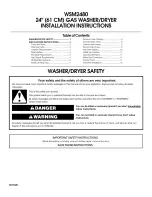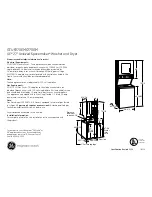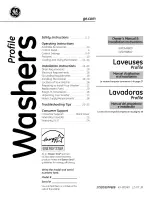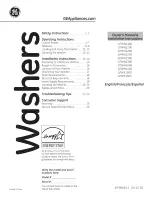
12
2. Fill the tank or mix as recommended by detergent
instructions (Fig. 19), and replace it back on the unit.
Secure the cap with suction tube back into place.
3. Install the soap nozzle (black) on the spray wand (Fig. 16).
4. Turn on the pressure washer. Pull the trigger to operate the
unit. The liquid detergent will automatically mix with water
and be discharged through the nozzle.
m
CAUTION!
Always test the detergent in an
inconspicuous area before use.
5. Turn the detergent dial to adjust the suction volume of the
detergent solution (Fig. 20).
6. Apply detergent from the bottom to the top of the dry
surface to be cleaned.
NOTE:
Wetting the surface first is not recommended as it
dilutes the detergent and reduces its cleaning ability.
7. Allow the detergent to remain on the surface for a short
time before rinsing. Do not allow the detergent to dry on
the surface.
m
CAUTION!
Damage may occur to painted surfaces if
the detergent is allowed to dry on the surface. Wash and rinse
a small section at a time. Avoid working on hot surfaces or in
direct sunlight.
8.
When finished using the pressure washer, you must first
drain and rinse the detergent tank. Run the pressure
washer until all of the soap is drained from the detergent
tank.
m
CAUTION!
Failure to follow these cleaning instructions
will cause the injection system to become clogged and
inoperable.
Rinsing with the Pressure Washer
1.
Turn off the pressure washer and shut off the water supply.
2. Pull the trigger to release water pressure.
3. Engage the safety lock on the trigger handle by pushing
up on the safety lock until it clicks into the slot (Fig. 13).
4. Remove the soap nozzle by placing your hand over the
nozzle while pulling back on the quick-connect collar.
5.
Select the right nozzle for the job (Fig. 21):
I) The 0º intense-jet nozzle (orange) is an extremely
powerful nozzle that delivers a high-pressure, pencil-
point jet stream. It is used to cut heavy dirt deposits
in a small, concentrated area. It is ideal for dissolving
stubborn substances, like tar and grease spots on
concrete, or for removing caked mud from equipment.
Use this nozzle to clean hard-to-reach areas including
the facades of 2-story buildings or the undersides of
lawn mowers and tractors.
NOTE: Care should be used when choosing the
right nozzle to avoid permanently gouging wood or
damaging fragile surfaces.
II) Use the 15º fan-tip nozzle (yellow) for intense cleaning
jobs on hard surfaces. Applications include stripping
paint, removing oil stains, grease, heavy mildew stains,
and rust from steel. This nozzle should only be used in
areas that can withstand the high-pressure from this
nozzle.
III) Use the 25º fan-tip nozzle (green) to clean home siding,
brick patios, wood decks, driveways, or sidewalks.
When using this nozzle, test a small area first to avoid
surface damage.
Fig. 19
Detergent
for pressure
washer
Detergent tank
Fig. 20
Detergent
dial
15º
SOA
P
25º
40º
0º
Fig. 21






































